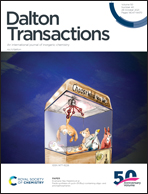Structure and reaction mechanism of binary Ni–Al oxides as materials for lithium-ion battery anodes†
Abstract
A nanometer sized solid solution of NiO and Al2O3 was synthesized by calcination of Ni–Al layered double hydroxides (LDHs). The crystal structure of the obtained compound was determined by XRD and XAFS analyses: Ni2+ and Al3+ ions are located at the metal ion site of the rock salt structure and a certain amount of cation vacancies are also introduced for charge compensation. The electrochemical properties of the Ni–Al binary metal oxide as an anode material for lithium ion batteries were examined by the constant current charge–discharge test. Ni–Al oxide showed higher charging capacity in comparison with pristine NiO. In particular, the capacity in the lower voltage region (below 1.5 V), the limited capacity in this region is the weak point of the conversion anode, was improved to 540 mA h g−1 that is about twice that of pristine NiO. This improvement in the capacity in the lower voltage region is concluded to be due to the redox activity of Al3+ ions during the charge–discharge on the basis of the results of electrochemical measurements and ex situ XAFS measurements at the Ni and Al edge. The reaction mechanism of this compound is investigated using ex situ XRD and XAFS methods. For the charge (reduction) in the higher voltage region (OCV–1.0 V), lithium ion intercalation into the cation vacancy sites and/or lithium ion adsorption on the surface of particles are proceeding. For the charge in the lower voltage region (1.0–0.03 V), conversion reaction occurs by the reduction of Ni2+ and Al3+ ions to metal particles with surface electrolyte interface (SEI) layer formation. For the discharge in the lower voltage region (0.03–1.5 V), only Al metal particles are oxidized to Al3+ ions and some intermediate complexes are formed. For the discharge in the higher voltage region (1.5–3.0 V), the lattice of the Ni–Al binary oxide solid solution is reconstructed with the oxidation of Ni to Ni2+.



 Please wait while we load your content...
Please wait while we load your content...